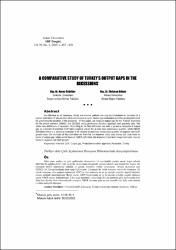| dc.contributor.author | Öztürkler, Harun | |
| dc.contributor.author | Göksel, Türkmen | |
| dc.date.accessioned | 2020-06-25T14:32:56Z | |
| dc.date.available | 2020-06-25T14:32:56Z | |
| dc.date.issued | 2015 | |
| dc.identifier.citation | Öztürkler, H., Göksel, T. (2015). A Comparative Study Of Turkey's Output Gaps In The Recessions. Ankara Üniversitesi SBF Dergisi, 70(2), 457 - 470. | en_US |
| dc.identifier.issn | 0378-2921 | |
| dc.identifier.issn | 1309-1034 | |
| dc.identifier.uri | https://app.trdizin.gov.tr/publication/paper/detail/TVRnMk5UQXpNdz09 | |
| dc.identifier.uri | https://hdl.handle.net/20.500.12587/242 | |
| dc.description.abstract | tkin para, maliye ve gelir politikaları ekonominin bir çevrimdeki yerinin ancak doğru tahmin edilmesi ile uygulanabilir. Çıktı açığı bir ekonominin döngüdeki yerinin tahmini için önemli bir araçtır. Bu makalede üretim fonksiyonu yöntemi ve çeyrek dönemlik veriler kullanılarak Türkiye ekonomisi için 2000Q1-2013Q4 periyodunda çıktı açığı ölçülmüştür. Çalışmada iki farklı resesyon tanımı ele alınmıştır. İlk olarak resesyon çıktı açığının potansiyel GDP?ye olan oranının en az iki ardışık çeyrekte negatif değerler alması şeklinde tanımlanmıştır. İkinci olarak, GDP büyümesinin en az iki ardışık çeyrekte negatif olmasını içeren NBER tanımı kullanılmıştır. Çıktı açığı tanımının kullanıldığı ilk kriz tanımına göre dış kaynaklı kriz daha kısa sürmüş fakat daha maliyetli olmuştur. NBER tanımına göre ise dış kaynaklı kriz daha uzun sürmüş ve daha maliyetli olmuştur. | en_US |
| dc.description.abstract | An effective set of monetary, fiscal, and income policies can only be formulated on the basis of a correct estimation of the position of an economy in a cycle. Output gap estimation provides an important tool for predicting the position of the economy. In this paper, we measure output gap for the Turkish Economy for the period between 2000Q1 and 2013Q4, using production function approach and quarterly data. We utilize two definitions of recession: According to the first definition, we refer a period as recession if output gap as a percent of potential GDP takes negative values for at least two consecutive quarters, while NBER definition refers to a period as recession if we observe at least two consecutive quarters of negative real GDP growth rates. On the basis of first definition we find that the imported crisis lasts shorter but costs more in terms of output gap; while on the basis of NBER definition, the imported crisis lasts longer and costs more in terms of negative real GDP growth. | en_US |
| dc.language.iso | eng | en_US |
| dc.rights | info:eu-repo/semantics/openAccess | en_US |
| dc.subject | Uluslararası İlişkiler | en_US |
| dc.subject | Siyasi Bilimler | en_US |
| dc.title | A Comparative Study Of Turkey’S Output Gaps In The Recessions | en_US |
| dc.title.alternative | Türkiye’deki Çıktı Açıklarının Resesyon Dönemlerinde Karşılaştırılması | en_US |
| dc.type | article | en_US |
| dc.contributor.department | Kırıkkale Üniversitesi | en_US |
| dc.identifier.volume | 70 | en_US |
| dc.identifier.issue | 2 | en_US |
| dc.identifier.startpage | 457 | en_US |
| dc.identifier.endpage | 470 | en_US |
| dc.relation.journal | Ankara Üniversitesi SBF Dergisi | en_US |
| dc.relation.publicationcategory | Makale - Ulusal Hakemli Dergi - Kurum Öğretim Elemanı | en_US |
















